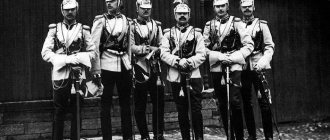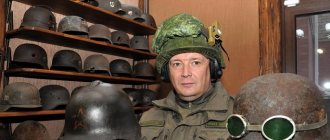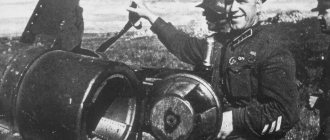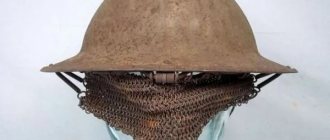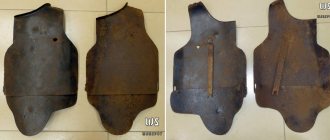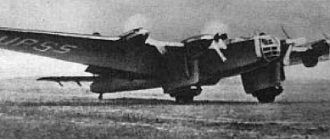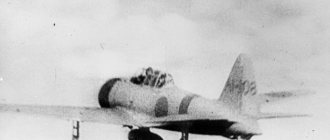THE USSR. Hard hats and helmets
Steel helmets
In the USSR, the topic of personal protective equipment for military personnel, including steel helmets, was addressed in the early 1930s. However, at first, a few “Adrian helmets” of French and Russian production could only be seen in parades by soldiers of elite units, for example, the Proletarian Division.
Red Army soldiers of the 1st Moscow Proletarian Rifle Division at the parade on May 1, 1938, wearing Adrian helmets.
In 1934, an order was issued to develop a new type of steel helmet. The sample presented to the military leadership was personally tested by Marshal Budyonny, chopping the helmet with a saber. Despite the fact that this episode is usually considered anecdotal, there was common sense in the marshal’s actions. Since the First World War, the steel helmet has been considered as a means of protection against shrapnel. The blow with the sword imitated the impact of shrapnel. On Budyonny’s initiative, the helmet that was eventually put into service received wide side brims designed to protect the fighter’s shoulders from a slashing blow from top to bottom (the brims were supposed to deflect the blade from the shoulder). The converted helmet was called the “Red Army steel helmet of the 1935 model”, in other sources - SSh-36, and later unofficially - “Khalkhingolka”.
Steel helmet (helmet) model 1936 - SSH-36.
The silhouette of the helmet was similar to a German M16 steel helmet. Worn like all other helmets with a liner. The SSH-36 received its baptism of fire during the war in Spain, where it was supplied to the Republicans and international brigades. In the summer of 1938, steel helmets were used during the fighting at Lake Khasan. Based on the results of an analysis of the injuries received by Red Army soldiers during the fighting near Lake Khasan, it was found that the presence of a helmet made it possible to reduce the mortality rate of Red Army soldiers from skull wounds to 5.8%. Subsequently, it was actively used by the Red Army in the battles at Khalkhin Gol, as well as in the Winter War and the Polish Campaign in 1939. However, during its application, a significant number of shortcomings were identified. Thus, the wide brim created a “sail effect” and made it difficult for the soldier to move, and the large visor reduced visibility. In strong winds, as well as when riding a horse, motorcycle, or in the back of a truck, this led to the helmet being blown to one side. In addition, the helmet was too heavy.
In 1937-1938, several experimental models of the new helmet were created and tested at the Rzhev test site. The shape of the new Soviet helmet resembled the steel Italian M33 helmet. It was this model that was taken as the basis when creating the helmet. The outline of the helmet, which became known as the SSh-39, acquired new contours. The weight of the SSh-39 was 1,250 grams, the wall thickness was 1.9 mm, and it was made of the best quality steel.
Helmet SSH-39.
The new helmet was painted olive or khaki; sometimes the outline of a five-pointed star was depicted on the front of the helmet. On the inside of the helmet, in the back of the head near the lower edge, on Soviet helmets a stamp of the manufacturer was affixed, as well as a stamp indicating the size of the helmet. The under-body device had a dome shape, was made, as a rule, of fabric (the under-body device could also be made of leather, leatherette or waxed fabric), framed in the lower part by a strip of leather or leatherette. A lining of cloth or felt was installed under the fabric. The size of the undercoat was adjusted using a cord located in the upper part of its dome. The fabric base was fastened to a steel hoop, which, in turn, with the help of holders, was attached to the surface of the helmet with three rivets, thus preventing the undercoat from coming into contact with the walls of the helmet, thereby providing ventilation and performing shock-absorbing functions.
Helmet SSH-40.
In 1940, a new type of steel helmet was adopted - “Steel helmet of the 1940 model” (SSh-40), which existed for several decades without any major changes. The design of the SSh-40 differs from the previous model, the SSh-39, in that it uses an under-body device that is simpler and stronger. Hence their main external difference: in the SSh-40, six rivets were used to fasten the under-tool device, in the SSh-39 - three. The sub-helmet device consists of three parts - “petals” made of leatherette, artificial leather or fabric, which are connected at the top of the helmet with a cord designed to adjust (adjust) the helmet for ease of wearing. On the inside of each petal there is a shock-absorbing pad made of cotton wool. The canvas chinstrap consists of two halves attached to rings on the sides of the helmet. One of the parts at the free end has a sliding buckle; the end of the other half is crimped with a semicircular metal mandrel. Unlike previous models of steel helmets, the SSh-40 was produced in only three sizes. The weight of the steel part of the helmet (without the under-tool device) of the largest size is 800 g. This helmet model not only survived the war, but was used for another decade after the war.
Air defense helmet
At the end of the 30s, the Soviet Union was preparing for a major war, and therefore, the need arose to create and equip civil defense forces and air defense units. To equip civil defense forces, as well as air defense units, a steel helmet was required. To solve this problem, such helmets began to be produced in Leningrad in 1938 at the Leningrad Metallurgical Plant. Unofficially, it received the designation “M38 Air Defense Helmet”. Along with air defense units, in conditions of lack of equipment, the helmet of this model was also used by the militias defending Leningrad. They gave him the second name “blockade runner.”
Air defense helmet - M-38.
Externally, the helmet was similar to the English Brodie helmet, and in fact, was a simplified version of the British model. The helmet was made of steel. The weight of the helmet was 1200 grams, the steel thickness was 1.8 mm, and the brim width was 35 mm. The balaclava was made of fabric and had a dome shape. The size of the balaclava was adjusted using a rope located at the top of the canopy. The fastening of the helmet liner was not reliable; it was fastened with two rivets located in the front and back of the helmet. The chin strap was made of fabric and attached using rectangular rings to special holders soldered to the helmet. The size of the chin strap was adjusted using a small square buckle. The helmets of this model were painted khaki. Sometimes an emblem was applied to the helmet, which was a schematic image of a five-pointed star, an anti-aircraft gun crossed with a searchlight beam, in the light of which the silhouette of an airplane was depicted, and a gas mask located between the two lower rays of the star. The air defense helmet was produced exclusively in Leningrad until mid-1943.
Pilot helmets
During the war years, leather flight helmets, winter and summer, were used, mostly pre-war production, which for the most part did not have space to accommodate headphones and a microphone. The number of models produced is quite large, but they mainly differed in the configuration and length of the helmet ears, fastener fittings and leather color. Since 1940, special pockets and mounts began to be made on helmets to accommodate headphones and a laryngophone. And later, in connection with the massive radio installation of aircraft, the radio headset became a mandatory built-in element of the headset. In 1943, Soviet industry launched the production of copies of the German headset LKpW-100 and LKpS-101, which were also produced in the post-war period in leather.
Winter leather helmets.
Winter helmet model 1940
A copy of the German winter headset LKpW-101, produced in the USSR since 1943.
Summer leather helmets.
Summer headsets of the 1940 model.
Parachutist helmets
Leather parachutist helmets.
Paratrooper's canvas helmet with goggles.
Parachutist's canvas helmet.
Tank helmets
In the mechanized forces (later the armored forces) of the Red Army, military personnel were equipped with helmets of the 1931 model and the 1934 model. Since the army at that time did not have radios or intercoms, the helmets were not headsets. In 1936, cavities were added to the 1934 model helmet to accommodate radio equipment, creating a real headset. The helmet was made both from leather and coated with avisent (a dense, wear-resistant fabric of special weave), and later from tarpaulin. On the “talking hat”, three headbands (rollers) were sewn from the forehead to the back of the head, and in the front part there was a sewn forehead pad (roller). On the sides there was either one roller, which was sewn in the center, or three, arranged in a fan. All rollers were filled with horsehair, and in later models with technical fiber. The rollers were intended to protect the head from impacts on protruding parts of the machine. The 1938 model helmet was made in summer and winter versions, and the model itself served throughout the war and was a model for post-war versions.
Leather helmet, model 1931.
Leather helmet, model 1934.
Leather helmet made from 1936.
Headset, model 1938, from avisent.
Winter headset, model 1938, from an advising note.
Navy sailor helmets
Leather helmets of a boat sailor and a submariner.
Share to:
From the beginning of Rus'
Warriors have worn helmets since time immemorial. Everyone is well aware of the images of ancient Greek hoplites and Roman legionnaires in their characteristic helmets.
Frame helmet
It’s interesting that if we start counting our statehood from 862, then the history of the Russian helmet will count from the same time. Of course, in those territories that a little later would be called the Novgorod or Kyiv principalities, helmets existed before.
Russian helmet with half mask and aventail
The Russian helmet, according to archaeological finds, began its journey in a fairly standard manner for northeastern Europe. According to the assumptions of scientists, for example, the most authoritative A.N. Kirpichnikov, the Russian helmet began its journey into history with the so-called spangenhelm frame helmet, popular among the ancient Slavic and Germanic tribes. Iron, copper or horn plates were placed on the metal frame. Often the helmet was equipped with additional elements: a mask, ears, and a backplate.
Shelom Ivan the Terrible
A little later, just at the time of the formation of the Rurik dynasty in Rus', the more modern Norman helmet competed with it. It already looks more like the classic helmet of a Russian hero. A well-developed nasal plate, a one-piece structure without a frame and a chain mail aventail - these are its main differences. At this time, pre-Mongol Russian helmets reached the peak of their development; they were very well made and richly decorated with carvings, silver or blackening, had masks and were of excellent quality.
Bigwig
Following him came the so-called shelom - a classic Russian pointed sphero-conical helmet, topped with a pronounced spire. The height of the helmet could reach up to 30 cm. Over time, the same ears, visors and aventails were added to the helmet. The shelom, along with the shishak that replaced it in the 16th century, became the most popular armor. Shelom and shishak were strongly influenced by Mongolian, and those in turn, Iranian helmets, but it was they who created the image of a Russian warrior equipped with a helmet and armor.
Misyurka
The shishak, which gradually replaced the shelham, no longer remained in service as long as its predecessors. The shishaku were accompanied by misyurki - small iron pommels with a well-developed aventail, as well as simply iron caps - compact and inexpensive helmets.
Iron cap taken from a cassette
Following them came Russian versions of the cabasset, a metal headband known to us from films and pictures about the Spanish conquistadors. The regiments of the new formation or archers were equipped with them, while the nobles continued to wear more expensive and high-quality shishaks. But firearms increasingly replaced iron armor and helmets from the battlefield, and by the end of the 16th century they practically disappeared from the battlefield.
Bascinet
At the beginning of the 14th century, the bascinet appeared. By that time, forging technology had taken a step forward, and therefore a new type of protection was made from one piece of metal. This significantly increased its strength.
The helmet had a semicircular shape, leaving the warrior’s face open, but protecting the cheeks and back of the head. Most often, an aventail was attached to it - a chainmail mesh that provided additional protection to the neck and face.
The picture clearly shows the fasteners on which a visor or aventail could be installed
Initially, the bascinet was considered a small helmet, which was worn under a large knight's helmet. But very quickly the knights received this headdress with a visor and became a full-fledged part of the armor. And among the infantry it has become one of the favorite types of defense.
Barbute
The Renaissance was accompanied by massive interest in antiquity. People began to read Greek and Roman authors, architecture began to focus on the Parthenon and Pantheon instead of Gothic, and elements of the classical style appeared in weapons. Thus, in the 15th century, the barbute appeared - a headdress created on the model of Greek helmets, which were found during excavations of settlements in Southern Italy.
The barbute was shaped like a bascinet, but protected not only the head and cheeks, but also most of the face. On the front of the helmet there was a cutout in the shape of the letter Y, by which the barbute is very easy to identify. This element of head protection gained popularity only in Italy, where the fascination with antiquity was strongest.
This helmet turned out to be inconvenient for mounted combat, so it became exclusively for infantry.
Spangenhelm
The most important type of early European helmet is the spangenhelm, or frame helmet. We see it, for example, on the Bayeux tapestry or in images of ancient Russian warriors.
Fragment of the Bayeux Tapestry
This helmet was very easy to manufacture. First, the frame parts were connected with rivets, and then the segments of the main part of the headdress were attached to them.
The spangenhelm of an elongated conical shape with a plate to protect the nose was called Norman, or nasal.
Despite the fact that these helmets began to lose popularity at the end of the 12th and 13th centuries, and knights switched to heavier protection, infantry and riflemen did not abandon them for a long time.
Chappelle
In the 13th century, inventive Europeans thought: why not make an ordinary hat, but only from iron. This is how the chaplain appeared, she is also a chapelle, she is an iron hat.” It was a very simple, but at the same time comfortable headdress.
It had many advantages. Firstly, the chapelle could be made from pieces of metal, fastening them with rivets, which greatly speeded up and reduced the cost of production. And secondly, it was light and gave a good overview for a warrior. In conditions of medieval battle, when it was necessary to carefully monitor what was happening around in order to understand in time when it was time to flee, this factor was very important. And thirdly, the iron hat had a wide brim that well protected the infantryman’s shoulders and could deflect a rider’s blow directed from above. And it was precisely such blows that the medieval infantry most often suffered. Chappelle lasted in the army right up to the 16th century.
